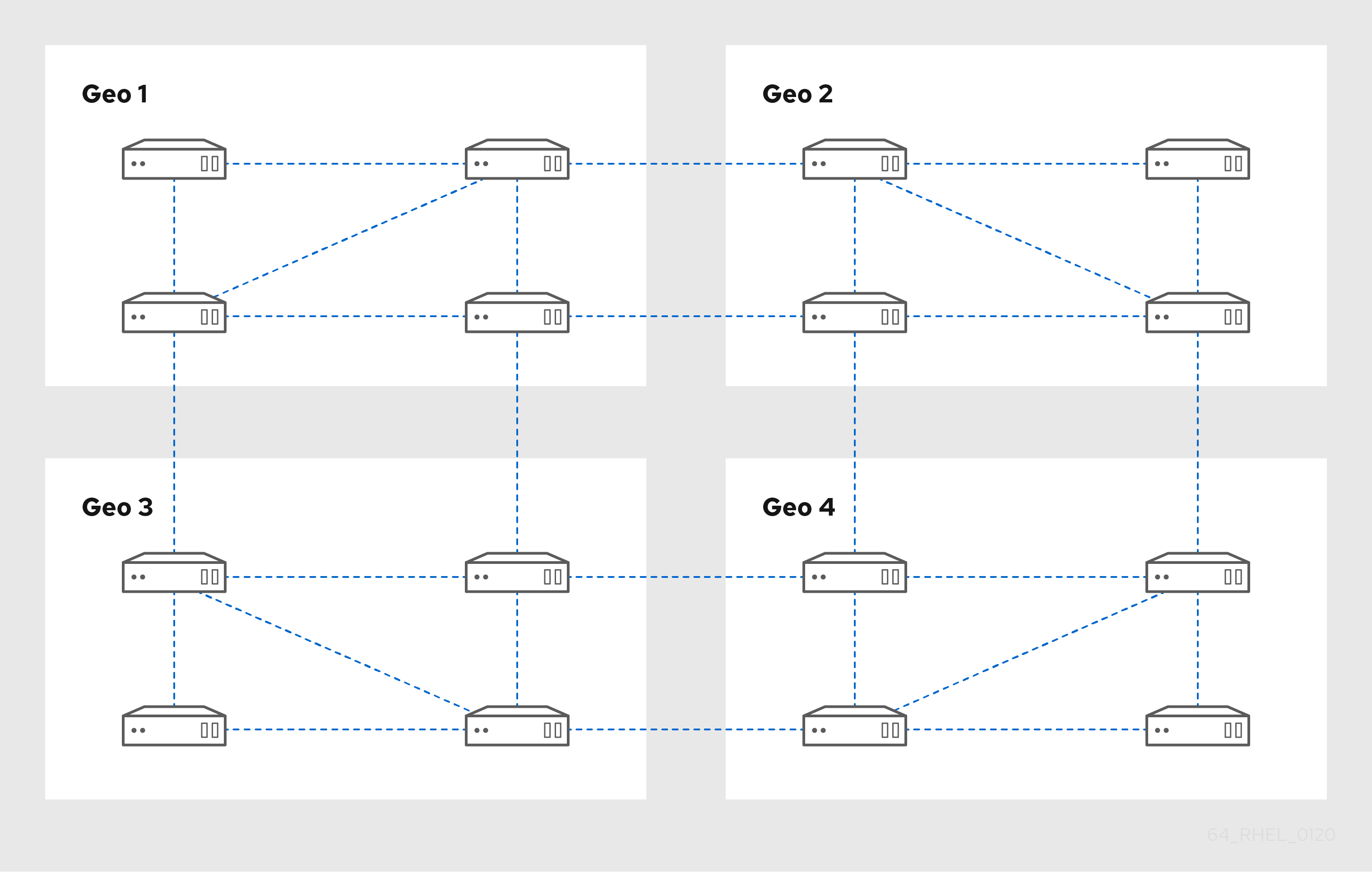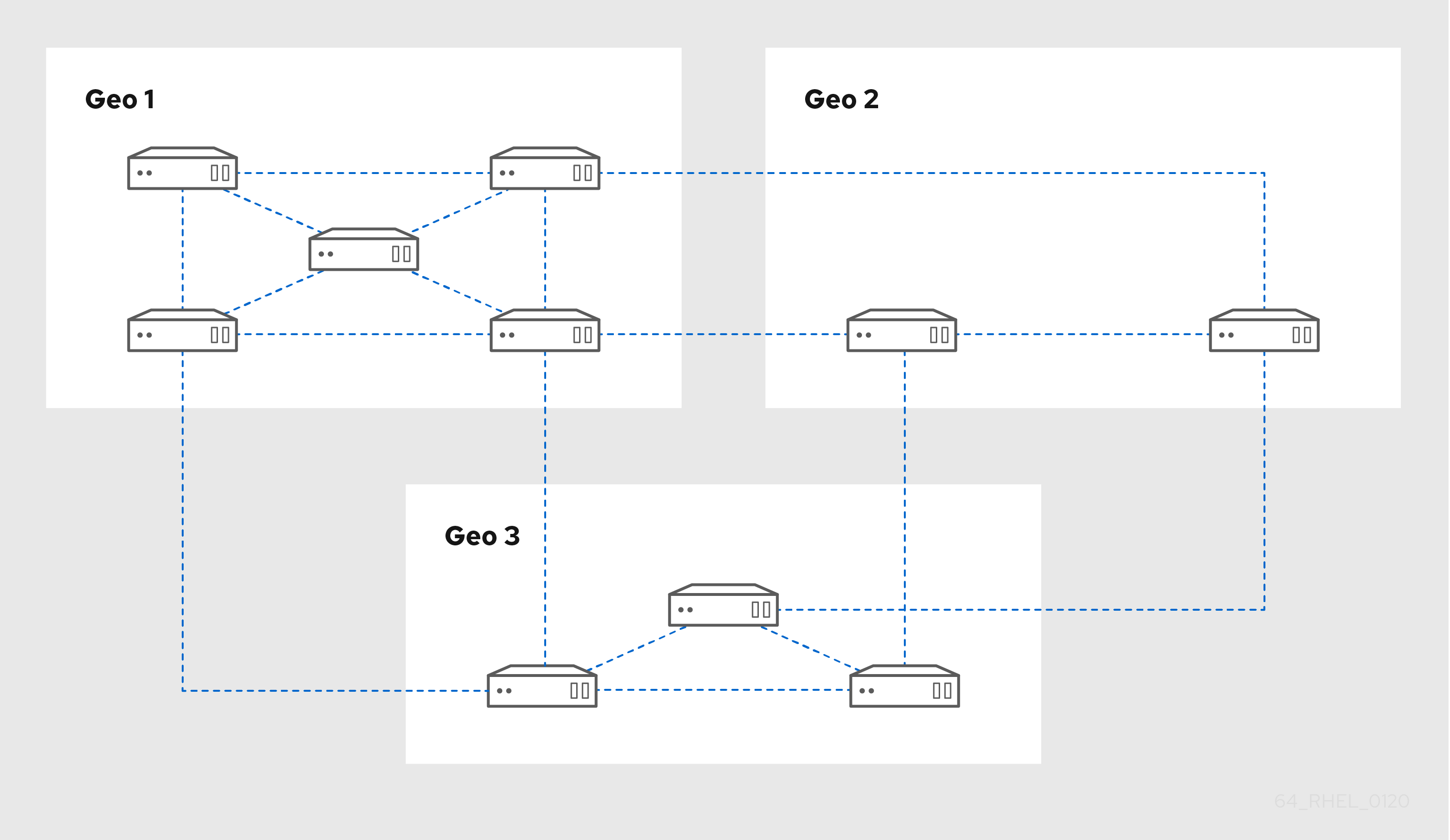Questo contenuto non è disponibile nella lingua selezionata.
Chapter 3. Planning the replica topology
Review guidance on determining the appropriate replica topology for your use case.
3.1. Multiple replica servers as a solution for high performance and disaster recovery
You can achieve continuous functionality and high-availability of Identity Management (IdM) services by creating replicas of the existing IdM servers.
When you create an appropriate number of IdM replicas, you can use load balancing to distribute client requests across multiple servers to optimize performance of IdM services. With IdM, you can place additional servers in geographically dispersed data centers to reflect your enterprise organizational structure. In this way, the path between IdM clients and the nearest accessible server is shortened. In addition, having multiple servers allows spreading the load and scaling for more clients.
Replicating IdM servers is also a common backup mechanism to mitigate or prevent server loss. For example, if one server fails, the remaining servers continue providing services to the domain. You can also recover the lost server by creating a new replica based on one of the remaining servers.
3.2. Introduction to IdM servers and clients
The Identity Management (IdM) domain includes the following types of systems:
- IdM clients
IdM clients are Red Hat Enterprise Linux systems enrolled with the servers and configured to use the IdM services on these servers.
Clients interact with the IdM servers to access services provided by them. For example, clients use the Kerberos protocol to perform authentication and acquire tickets for enterprise single sign-on (SSO), use LDAP to get identity and policy information, and use DNS to detect where the servers and services are located and how to connect to them.
- IdM servers
IdM servers are Red Hat Enterprise Linux systems that respond to identity, authentication, and authorization requests from IdM clients within an IdM domain. IdM servers are the central repositories for identity and policy information. They can also host any of the optional services used by domain members:
- Certificate authority (CA): This service is present in most IdM deployments.
- Key Recovery Authority (KRA)
- DNS
- Active Directory (AD) trust controller
- Active Directory (AD) trust agent
IdM servers are also embedded IdM clients. As clients enrolled with themselves, the servers provide the same functionality as other clients.
To provide services for large numbers of clients, as well as for redundancy and availability, IdM allows deployment on multiple IdM servers in a single domain. It is possible to deploy up to 60 servers. This is the maximum number of IdM servers, also called replicas, that is currently supported in the IdM domain.
When creating a replica, IdM clones the configuration of the existing server. A replica shares with the initial server its core configuration, including internal information about users, systems, certificates, and configured policies.
- NOTE
- A replica and the server it was created from are functionally identical, except for the CA renewal and CRL publisher roles. Therefore, the term server and replica are used interchangeably in RHEL IdM documentation, depending on the context.
However, different IdM servers can provide different services for the client, if so configured. Core components like Kerberos and LDAP are available on every server. Other services like CA, DNS, Trust Controller or Vault are optional. This means that different IdM servers can have distinct roles in the deployment.
If your IdM topology contains an integrated CA, one server has the role of the Certificate revocation list (CRL) publisher server and one server has the role of the CA renewal server.
By default, the first CA server installed fulfills these two roles, but you can assign these roles to separate servers.
The CA renewal server is critical for your IdM deployment because it is the only system in the domain responsible for tracking CA subsystem certificates and keys. For details about how to recover from a disaster affecting your IdM deployment, see Performing disaster recovery with Identity Management.
- NOTE
- All IdM servers (for clients, see Supported versions of RHEL for installing IdM clients) must be running on the same major and minor version of RHEL. Do not spend more than several days applying z-stream updates or upgrading the IdM servers in your topology. For details about how to apply Z-stream fixes and upgrade your servers, see Updating IdM packages. For details about how to migrate to IdM on RHEL 8, see Migrating your IdM environment from RHEL 7 servers to RHEL 8 servers.
3.3. Replication agreements between IdM replicas
When an administrator creates a replica based on an existing server, Identity Management (IdM) creates a replication agreement between the initial server and the replica. The replication agreement ensures that the data and configuration is continuously replicated between the two servers.
IdM uses multiple read/write replica replication. In this configuration, all replicas joined in a replication agreement receive and provide updates, and are therefore considered suppliers and consumers. Replication agreements are always bilateral.
Figure 3.1. Server and replica agreements
IdM uses two types of replication agreements:
- Domain replication agreements replicate the identity information.
- Certificate replication agreements replicate the certificate information.
Both replication channels are independent. Two servers can have one or both types of replication agreements configured between them. For example, when server A and server B have only domain replication agreement configured, only identity information is replicated between them, not the certificate information.
3.4. Guidelines for determining the appropriate number of IdM replicas in a topology
Plan IdM topology to match your organization’s requirements and ensure optimal performance and service availability.
- Set up at least two replicas in each data center
- Deploy at least two replicas in each data center to ensure that if one server fails, the replica can take over and handle requests.
- Set up a sufficient number of servers to serve your clients
- One Identity Management (IdM) server can provide services to 2000 - 3000 clients. This assumes the clients query the servers multiple times a day, but not, for example, every minute. If you expect frequent queries, plan for more servers.
- Set up a sufficient number of Certificate Authority (CA) replicas
- Only replicas with the CA role installed can replicate certificate data. If you use the IdM CA, ensure your environment has at least two CA replicas with certificate replication agreements between them.
- Set up a maximum of 60 replicas in a single IdM domain
- Red Hat supports environments with up to 60 replicas.
3.5. Guidelines for connecting IdM replicas in a topology
- Connect each replica to at least two other replicas
- This ensures that information is replicated not just between the initial replica and the first server you installed, but between other replicas as well.
- Connect a replica to a maximum of four other replicas (not a hard requirement)
A large number of replication agreements per server does not add significant benefits. A receiving replica can only be updated by one other replica at a time and meanwhile, the other replication agreements are idle. More than four replication agreements per replica typically means a waste of resources.
NoteThis recommendation applies to both certificate replication and domain replication agreements.
There are two exceptions to the limit of four replication agreements per replica:
- You want failover paths if certain replicas are not online or responding.
- In larger deployments, you want additional direct links between specific nodes.
Configuring a high number of replication agreements can have a negative impact on overall performance: when multiple replication agreements in the topology are sending updates, certain replicas can experience a high contention on the changelog database file between incoming updates and the outgoing updates.
If you decide to use more replication agreements per replica, ensure that you do not experience replication issues and latency. However, note that large distances and high numbers of intermediate nodes can also cause latency problems.
- Connect the replicas in a data center with each other
- This ensures domain replication within the data center.
- Connect each data center to at least two other data centers
- This ensures domain replication between data centers.
- Connect data centers using at least a pair of replication agreements
- If data centers A and B have a replication agreement from A1 to B1, having a replication agreement from A2 to B2 ensures that if one of the servers is down, the replication can continue between the two data centers.
3.6. Replica topology examples
You can create a reliable replica topology by using one of the following examples.
Figure 3.2. Replica topology with four data centers, each with four servers that are connected with replication agreements
Figure 3.3. Replica topology with three data centers, each with a different number of servers that are all interconnected through replication agreements


